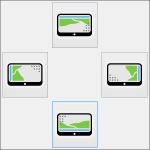I see myself am a Windows fanboy and an early adopter. I really do. (Don’t mistake me for a Microsoft fanboy. That is something completely different.)
This week, by chance, I found Windows 8.1 on my DreamSpark account. I was smart enought to ignore the preview so far, thus I was able to continue working, but since neither the title nor the description of the Dreamspark download mentioned anything about being a preview, I thought, this might be the real thing, released a bit early to Dreamspark users, like Microsoft sometimes does. That said, I downloaded it and installed Windows 8.1 on my laptop.
To spoiler: Right now, while I am writing this article, I am performing a clean installation on Windows 8(.0) on my laptop.
When I switched from Windows 7 to Windows 8, I quickly got used to the new interface, and I liked many of the new features. Of course, a start button would be nice and the start screen (aka full screen start menu) has a strange way of (un-)organization, but I was able to work rather efficiently with all of it.
Then I tried Windows 8.1 … I don’t want to write “yet another flame-post”, therefore I will limit myself to just one single feature: local accounts.
I have a local PC (stands for “personal” computer). I impersonate several roles when using this PC, e.g. being myself when I do online shopping, being my working self when answering e-mails from one of my mail accounts (I currently use 5 different accounts), being my gaming self when I do online gaming, etc. I could continue this list. What is important here, is that I fullfil different roles when using my computer, but I am always myself. Thus I use my account to do all this. And my account is my local account and not a Microsoft account forible tied with a Microsoft e-mail address.
I don’t want to use a Microsoft account on my local personal computer.
I don’t want to use a Microsoft account on my local personal computer.
I don’t want to use a Microsoft account on my local personal computer.
So, after some hardship I finally managed to use a local user account in windows 8.1 as well, but then suddenly I was no longer able to use several features of Windows. Several Apps stopped working. Yes, they state that I can log into my Microsoft account independently, but with some of the Apps, this really does not work.
More importantly: SkyDrive cannot be used with a local user account.
At least, I was not able to find any work-around to get any SkyDrive integration installed or working. This is a true show-stopper. The improved SkyDrive integration ensures that I will always have enough storage space on my cloud, since I cannot use it any more. Sad. Truely sad.
Well, as stated above, I am switching back to Windows 8(.0) and I will suppress my early-adoper-urges until I get proof that local accounts are again useable with the next windows.
If you want to read more about this misery, I liked reading this article: http://www.tweakguides.com/Windows81_1.html (especially page 3).












